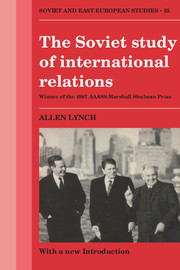Book contents
- Frontmatter
- Contents
- Foreword by Curt Gasteyger
- Acknowledgements
- INTRODUCTION: THE “ NEW POLITICAL THINKING” AND SOVIET FOREIGN POLICY: INTELLECTUAL ORIGINS AND POLITICAL CONSEQUENCES
- INTRODUCTION TO THE FIRST EDITION
- 1 THE BACKGROUND: MARX, LENIN, STALIN AND THE THEORY OF INTERNATIONAL RELATIONS
- 2 THE DEVELOPMENT OF SOVIET POLITICAL STUDIES
- 3 APPROACHES TO INTERNATIONAL RELATIONS
- 4 THE SYSTEMS APPROACH AND INTERNATIONAL RELATIONS
- 5 THE STRUCTURE OF THE INTERNATIONAL SYSTEM: THE SYSTEMS LEVEL
- 6 CRITICAL SUBSYSTEMS
- 7 THE SCIENTIFIC–TECHNICAL REVOLUTION AND THE CHANGING FACE OF INTERNATIONAL RELATIONS
- CONCLUSION
- Notes
- Bibliography
- Index
- SOVIET AND EAST EUROPEAN STUDIES
7 - THE SCIENTIFIC–TECHNICAL REVOLUTION AND THE CHANGING FACE OF INTERNATIONAL RELATIONS
Published online by Cambridge University Press: 05 August 2011
- Frontmatter
- Contents
- Foreword by Curt Gasteyger
- Acknowledgements
- INTRODUCTION: THE “ NEW POLITICAL THINKING” AND SOVIET FOREIGN POLICY: INTELLECTUAL ORIGINS AND POLITICAL CONSEQUENCES
- INTRODUCTION TO THE FIRST EDITION
- 1 THE BACKGROUND: MARX, LENIN, STALIN AND THE THEORY OF INTERNATIONAL RELATIONS
- 2 THE DEVELOPMENT OF SOVIET POLITICAL STUDIES
- 3 APPROACHES TO INTERNATIONAL RELATIONS
- 4 THE SYSTEMS APPROACH AND INTERNATIONAL RELATIONS
- 5 THE STRUCTURE OF THE INTERNATIONAL SYSTEM: THE SYSTEMS LEVEL
- 6 CRITICAL SUBSYSTEMS
- 7 THE SCIENTIFIC–TECHNICAL REVOLUTION AND THE CHANGING FACE OF INTERNATIONAL RELATIONS
- CONCLUSION
- Notes
- Bibliography
- Index
- SOVIET AND EAST EUROPEAN STUDIES
Summary
The question as to which purposes the fruits of the scientific and technical revolution will be used for has become one of the chief questions in the contemporary socio-political struggle.
The mid–1970s witnessed a new tack in both Soviet assessments of the objective evolution of international relations and in Soviet declarations about the desired outcome of that evolution. International relations were said to be undergoing a fundamental “restructuring,” breaking from the structural and behavioral patterns characterizing world politics from roughly 1945 to 1972, to “new” principles more in accordance with Soviet interests and, indeed, the interests of mankind. The concept of the “general restructuring of international relations,” as R. Judson Mitchell notes, “emphasizes growing Soviet power in the world, changes in the relationships between competing systems, and internal structural transformations within those systems.” Nevertheless, “the doctrine reflects in many respects a basic continuity in the Soviet approach to world politics.” To a large extent the concept is a corollary to the Soviet doctrine of peaceful coexistence which, when established as an operative principle of international relations, functions as the objective precondition for the restructuring of those relations. The very idea of “detente,” which in the Soviet lexicon is the process whereby the capitalist world is compelled to accept the principle of peaceful coexistence, is critical for the achievement of the desired restructuring.
- Type
- Chapter
- Information
- The Soviet Study of International Relations , pp. 131 - 139Publisher: Cambridge University PressPrint publication year: 1987



